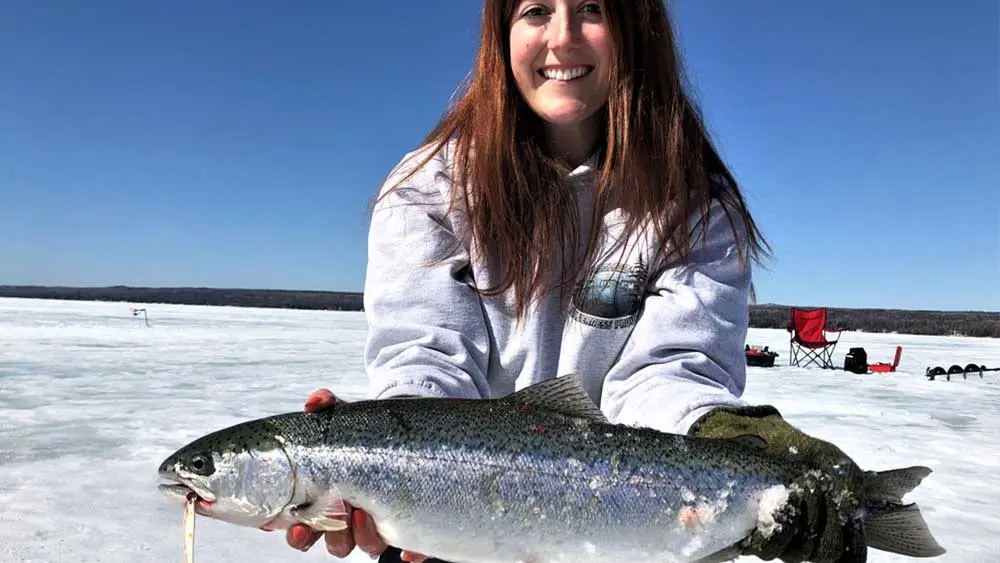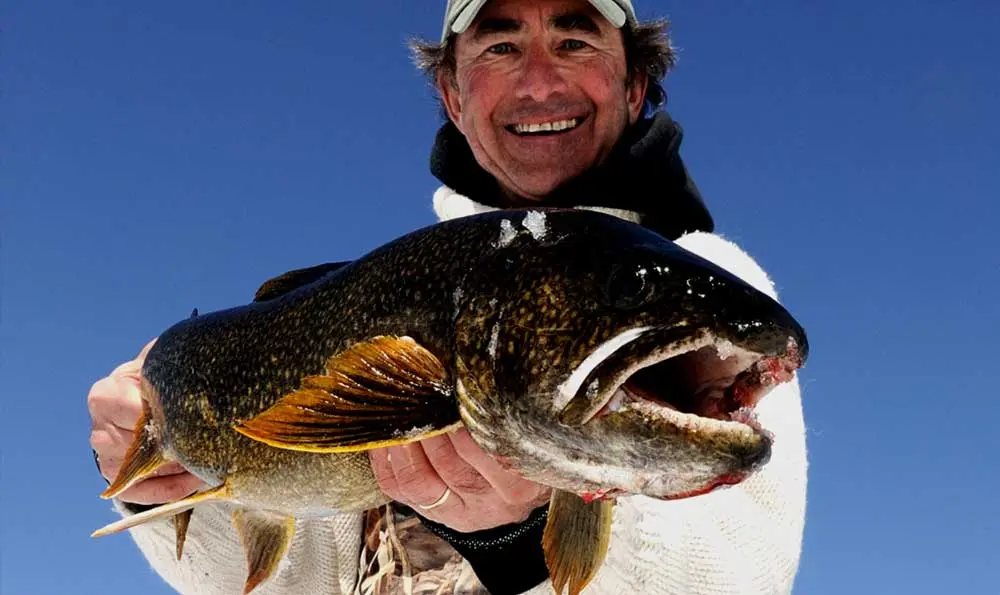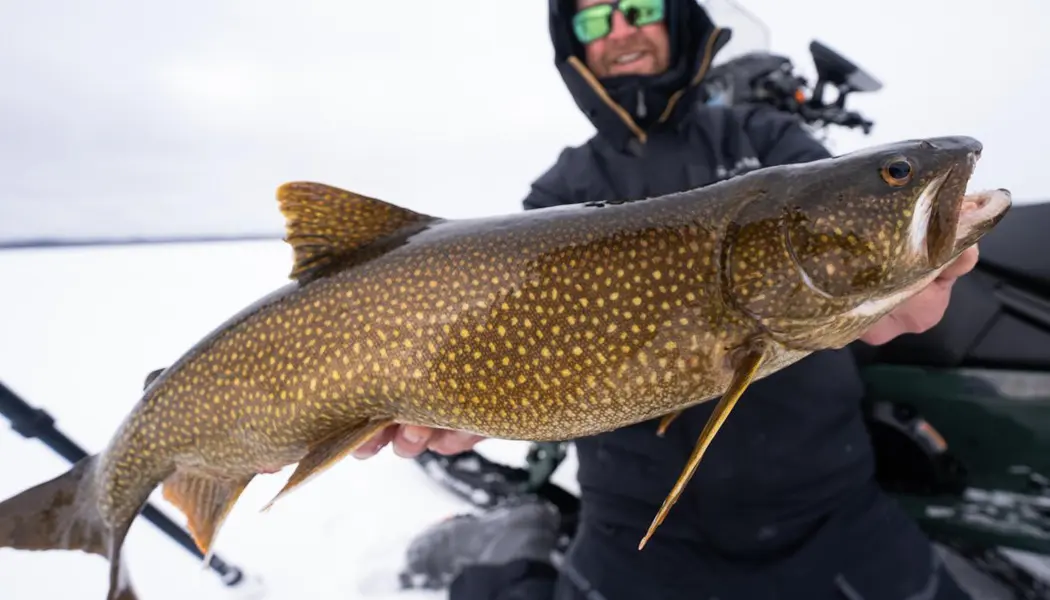Best ice fishing in Northern Ontario

Bays End of Lake Superior | Gord Ellis
The sheer number of spectacular opportunities and species is truly remarkable. Here is a selection of some of the best ice fishing experiences.
Whitefish Lake
Located west of Thunder Bay, Whitefish Lake is 30 square kilometres in size, and has a maximum depth of seven metres. It’s a long, shallow fish factory. The lake has a strong population of walleye, with fish approaching 10 pounds caught every winter. The best fishing for walleye happens during first ice and into January and then again at last ice before the season ends on April 15.
There’s a pronounced morning and evening bite and a strong night bite, when many of the largest walleye are caught. Anglers do well fishing with a quarter-ounce glow Fireball jig and minnow. Large walleye are caught using a sucker minnow under a tip-up.
The second most popular species in Whitefish Lake is the yellow perch. These tasty panfish are common in the lake, with enough jumbo-sized fish to keep it interesting. Many perch are caught using tiny panfish jigs baited with white tubes or small twisters. Dead stick rods with small minnows are also a good combination.
Other species present in Whitefish Lake include northern pike and smallmouth bass. There is the occasional large pike, but most will be under 10 pounds. Bass are a rare catch in the winter, but they grow big in Whitefish Lake.
Resorts and cottages on Whitefish Lake
For more information about fishing on Whitefish Lake, visit Superior Country.
Lac des Mille Lacs
This sprawling, complex water body is also the most popular winter walleye ice fishing destination in the Thunder Bay area. Lac des Mille Lacs has an area of 245.1 square kilometres and a drainage basin of 1,774.55 square kilometres. Lac is known for its dark-stained water, which allows for great daytime walleye fishing. Although there are deep sections on the lake, much of the fishing is done in the relatively shallow water of seven metres or less.
Winter walleye in Lac can be caught by jigging, either with a minnow on a quarter ounce lead head jig, or with a jigging spoon. The Hopkins Smoothie, Swedish Pimple or Northland Buckshot Rattle Spoon are all excellent jigging spoon choices. Tip the hook with a minnow head for extra appeal.
Many of the largest walleye are caught on large chub or sucker minnows on set lines. Northern pike are plentiful in Lac des Mille Lacs, with some specimens approaching the 15- to 20-pound mark.
Pike are frequently a by-catch when walleye fishing but can be targeted with a frozen herring or a live sucker under a tip-up. Quick strike rigs allow the pike to be hooked in the mouth and not down the throat. Some perch are caught in Lac des Mille Lacs as well, but they are more of an occasional bonus than a target species.
Lodges and ice fishing hut rentals on Lac Des Mille Lacs
For more information about ice fishing on Lac Des Mille Lacs, visit Superior Country.
Black Bay, Lake Superior
If catching large amounts of jumbo perch appeals to you, look no further than Black Bay. This huge bay sits between the City of Thunder Bay and the town of Nipigon. Black Bay is much shallower than most of Lake Superior and the water is cloudy. Because of this, the fishery is predominantly made up of warm water species like perch, walleye and bass.
Perch is the primary focus in the winter as more than half of the bay is closed for walleye fishing. From Bent Island northward no walleye can be fished in Black Bay. Luckily, the perch fishing is great and some true jumbos that measure up to 14 inches (35 centimetres) can be caught.
Perch are caught with light panfish jigs and plastic tubes, twisters or small minnows. Dead stick lines with a small minnow on a single hook, or on a small Northland Buckshot spoon, will also get big perch. In addition to perch, there are also some other species that show up in the winter including whitefish, herring, lake trout and huge pike.
Outfitters, baits and ice hut rentals on Black Lake
For more information about ice fishing on Black Bay, visit Superior Country.
Bays End, Thunder Bay
Located at the far east end of Lake Superior’s Thunder Bay, Bay’s End has a rich and diverse cold-water fishery. While located only minutes east of the city of Thunder Bay, Bay’s End has fishing opportunities for lake trout, whitefish, herring, burbot and steelhead that rival most destinations in Canada.
Lake trout are found in depths from seven to 30 metres, although most are found at about 21 metres. Jigging with a half-once or 3/4-ounce silver Swedish Pimple, Buzz Bomb or Gibbs Kroc spoon will attract trout focused on eating smelt.
You can also use the larger-sized white tube jigs like the Droptine Tackle Hunger Strike tube. Hanging a frozen herring or sucker just off the bottom can also get trout to bite. Most lake trout will be four to eight pounds, but fish approaching 20 pounds are possible.
Whitefish are common in Bay’s End and grow quite large, upwards of 30 inches (76 centimetres) or more. Most whitefish are in water from six to 15 metres deep and respond to smaller jigging spoons. The Williams Ice Jig and Pilkki spoon are two of the better choices.
Lake herring suspend in the water column, often just below the ice. Many anglers look down their ice hole and sight fish them. Herring have a small mouth so can be tricky to catch. Small jigging spoons will catch them but adding a trailer line off the spoon and adding a pearl bead with a treble is even better.
Steelhead are usually found in less than seven metres of water. They are aggressive fish and will hit a wide variety of jigging spoons, tubes and bucktail jigs. Some anglers hang trout eggs on set lines just below the ice for steelhead.
For more information about ice fishing on Bays End, visit Superior Country and Thunder Bay.
Lake of the Woods
Lake of the Woods is actually several unique water bodies that are all interconnected. The lake has 104,000 kilometres of shoreline and over 14,500 islands. The Canadian side of Lake of the Woods offers fishing for just about every warm water species you can find in Northwest Ontario.
The lake offers a wide variety of fishing opportunities, both in shallow and deep water. The species available include walleye, crappie, northern pike, whitefish and perch. There are also great fishing opportunities for big lake trout.
Walleye will usually be found in deeper waters, from 10 to 20 metres. Jigging a spoon or blade bait is a popular way to catch winter walleye on Lake of the Woods, with the Northland Forage Minnow and Berkley Vibrato being the top picks.
Crappie and perch fishing are popular in the Nestor Falls and Sioux Narrows areas. Crappie are a schooling fish, and any of the best areas get busy with anglers in pop-up tents and shacks. Perch can be found hugging the bottom in deeper water while crappie tend to suspend in the water column.
Lake trout fishing on Lake of the Woods normally starts January 1. Lake trout are often caught when using white tube jigs, Swedish Pimple spoons and large rubber plastics such as the Droptine Tackle Hungerstrike Tube or Bondy Bait. Lake trout average five to 15 pounds but they can grow much larger.
Lake of the Woods has a variety of places to fish for lake trout, which can occasionally be found mixed in with walleye.
Outfitters and resorts on Lake of the Woods
For more information about ice fishing on Lake of the Woods, visit Sunset Country.
Wawa Lake/Wawa
Wawa Lake is not a huge lake as some of the northern watersheds go, yet it is the focal point of one of the largest annual ice fishing events in Canada. The Wawa Ice Fishing Derby awards $150,000 in prizes and cash, which is why it attracts anglers from across North America during the first weekend in March every year.
The main derby lake is Wawa Lake, which has lake trout and pike. Lake trout are generally caught here with jigging spoons including the Hopkins Smoothie, Kastmaster and Luhr Jensen Crippled Herring. White tube jigs or a ball head and Berkley Power Minnow will also take trout. Pike can be caught on a sucker minnow on a tip-up.
Hawk Lake is primarily a walleye and pike fishery with most of the fish being caught on a jig and minnow combination. Larger pike will hit a frozen herring set under a tip-up. Manitowik Lake sees anglers hanging a large sucker minnow on a set line, which has been known to land a few lake trout and walleye derby winners.
Lakers will average three to five pounds, but some years fish up to 14 pounds have been entered. Walleye will average closer to three pounds, with the occasional nine-pound fish. Northern Pike average five to seven pounds. As a bonus, lakes with stocked speckled trout and splake are close to Wawa and could make a visit to the Wawa Ice Fishing Derby a weeklong adventure.
For more information about ice fishing on Lake Wawa, visit Algoma Country.
Lake Temagami
Lake Temagami sits approximately 80 kilometres north of North Bay in the heart of the north. The lake’s name comes from Te-mee-ay-gaming, which means "deep water by the shore" in Ojibwa. Lake Temagami is 20,979 hectares in size and has a maximum depth of 110 metres. This deep, clear water provides the perfect habitat for lake trout, walleye and whitefish. This makes Temagami a popular destination for winter anglers.
Lake trout in Temagami will be found between 10 and 35 metres, with the deep basins holding the largest fish. Anglers catch the majority of the lake trout jigging. Spoons are a popular presentation, with the Luhr Jensen Krocodile, Swedish Pimple and Northland UV Buckshot Rattle Spoon being top choices.
Hard-bodied lipless crankbaits are also popular here, with the Rapala Rippin’ Rap and Jackall TN 60 both great options for large trout. Jig these lures aggressively, watching your line on the drop. White or white/blue tube jigs with a small stinger hook also account for many fish. The average Temagami Lake trout will run three to four pounds, but fish approaching 40 pounds are possible.
Walleye in Temagami thrive in seven to 20 metres of water, and evening is often when they bite best. Jigging with a spoon or jig that has glo paint will increase the number of bites as will tipping the lure with a minnow. A set line with a large minnow hooked on a quarter ounce jig is also a good option for walleye. Other fish that can be caught ice fishing in Temagami include whitefish and burbot.
Lodges on Lake Temagami
For more information about ice fishing on Lake Temagami, visit Northeastern Ontario.
Lake Nipissing
Lake Nipissing was named the number one ice fishing destination in Canada for 2023 by Fishing Booker.
Lake Nipissing is located between the Ottawa River and Georgian Bay and is the third-largest lake entirely located in Ontario. It has a surface area of 873 kilometres and drains into Georgian Bay via the French River. The name Nipissing derives from an Ojibwa word meaning "little water," possibly a comparison to the nearby Great Lakes.
Lake Nipissing is a very popular ice fishing destination. The most sought-after fish in the area is walleye, but there are several other winter species including perch, pike, herring, whitefish and burbot.
Lake Nipissing walleye are caught in a variety of ways. The classic presentation is a set rod with a minnow, hook and single split shot. Using a light action rod on a pail or in a rod holder will allow the angler to see light bites from fish. Jigging spoons such as Swedish Pimples or the Northland Forage Minnow are also productive. Blades baits including the Berkley Vibrato can trigger hard walleye strikes as well.
Northern pike are a common catch in Nipissing with numbers of fish up to 10 pounds and the occasional trophy. Anglers targeting pike on Lake Nipissing generally use large chubs, sucker minnows or frozen herring under a tip-up. It’s not uncommon to hook pike while perch or walleye fishing as these fish make up a portion of the predator’s diet.
Yellow perch are the third most targeted fish on Nipissing. The bait of choice for perch is small minnows on a spreader rig or a minnow jigged on a tiny lead-head jig. Small-sized spoons like the Northland Buckshot spoon and micro tube jigs can also be productive.
Related content
Last updated: October 27, 2025


